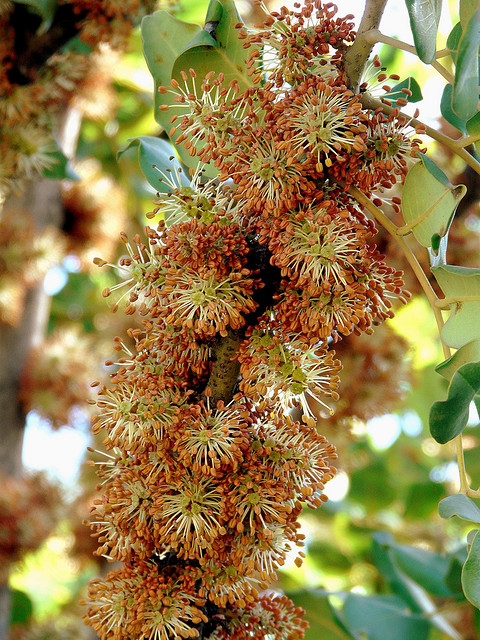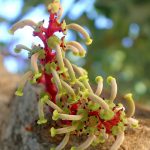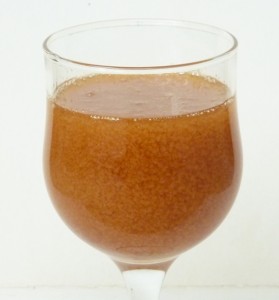When it comes to honey, carob does not play second fiddle to chocolate. Chocolate is produced from the cacao tree, but it is not a nectar-producing tree. So carob stands alone as the source of this delicious chocolate-scented honey!
The carob “tree” is actually a member of the legume family, joined by other well known honey-producing trees such as Acacia and Black Locust.
The carob tree comes in separate male and female trees. Flowers of the male are stamen clusters with pollen, producing a very strong odor, while the female produces small, yellow, aromatic flowers (pistals), grouped in clusters. Both male and female flowers produce nectar and attract large numbers of insects. As they are unable to self-pollinate, this is a task left to insects, bees and the wind.
The commercially important seed pods are produced by female trees. Typically one male tree is planted for 10 to 20 female trees, or female branches are grafted onto male stock.
The carob tree has been known for at least 4,000 years. In the Gospels of Matthew and Mark we read that John the Baptist ate in the desert of “wild honey locusts,” a possible allusion to the shape of carob pods. For this reason, Carob beans are known in England as “St. John ‘s bread.”
Single flower Carob honey is somewhat rare and is available through commercial Carob tree farming. Harvested in the autumn, Carob honey is dark amber and crystallizes easily into a soft coarse texture. This delicious honey has a warm flavor with a medium aromatic intensity. It is infused with chocolate and herbal overtones and has a slightly bitter aftertaste. It is a unique and delicious honey.
With a taste very similar to chocolate, carob is often used as a healthy substitute, as it lacks caffeine and has less fat than chocolate. A native of the Mediterranean and possibly the Middle East, it was carried around the world by explorers and settlers.
Spaniards carried carob to Mexico and South America, and the British took carob to South Africa, India, and Australia. The Carob tree was introduced into California from Spain by missionaries in the 1850’s and is a popular tree there and in Arizona.
Carob seeds have a history of their own. The carat weight measure used for gemstones originated from the weight of the carob seed, which was thought to be very consistent (now proven not to be any more consistent than any other seed). The word carat stems from the Arabic word qīrāṭ which was a very small unit of weight defined by reference to the carob seed. 5 carob seeds equals one gram. A caret weight is 200 milligrams.
Carob seeds contain a gum called locust bean gum or carob gum. Among its many uses it is a thickening or gelling agent used by the food industry in ice cream and many other foods.
In Israel the Carob tree has a special meaning for the annual arbor day festival (Tu Bushvat) and in Cyprus they have an annual Carob festival to recognize the traditional importance of this crop.
Translations: Italian: Miele di carrubo or Carruba; Malta: ħarrub għasel; French: Miel de Caroubier; German: Johannisbrotbaum Honig; Spanish: Miel de alagarrobo or algarroba; Greek: χαρούπι μέλι
Sources: Main: Spain and Portugal on the Atlantic coast Secondary: Italy (Sicily, Sardinia and smaller islands), France, Greece/Crete, Argentina
Latin name: Ceratonia siliqua
Image Credit: Bambo Creative Commons License





I have a 12 year old carob (male, judging by odour)planted very close to my patio. Roots are now visible in the lawn. Will it hurt the tree to shop these away? Hopefully this is not a stupid question, Thank you for answering
Has anyone done anything with crushed carob seed or powdered seed
Hi,
Thanks for the information on this site about the carob tree. I have a few of them on my property. I now am better armed for identifying the male carob trees.
Hi Dee Harris,
I think you will be fine if you chop away the side roots especially the ones at the surface. The carob tree is sustained by it´s very long tap root.
Hello,
Do you know where to buy carob honey in California or anywhere in the U.S?
Hi Pilar:
I recommend searching for it on Google and buying it online. Many beekeepers sell this way, although you may have to use Google Translate, it has been worth it for my online honey purchases. I have had good luck buying from France, UK and New Zealand, but I think just about any European country would be low risk.
…Scott
Hello! I am a new beekeeper in Crete (largest greek island) and this year for first time i produced honey from carob trees. During the carob tree blossom the Erica blossom occured too so the honey is a mix from these two plants. Some find it delicious, some others are not familiar with the chocolate-similar carob taste. I would like to have some more experienced opinion.
Sounds fantastic would love to try some one day.
Goats love eating the pods I saw them doing so in Oman when we stoped to get petrol for our truck on the way to Yemen. Its a lovely shady tree that seems to grow where very little else succeeds.
Hello, this is one of the most delicious honey I’ve tasted!
My family sells Carob Honey in the UK from Morocco.